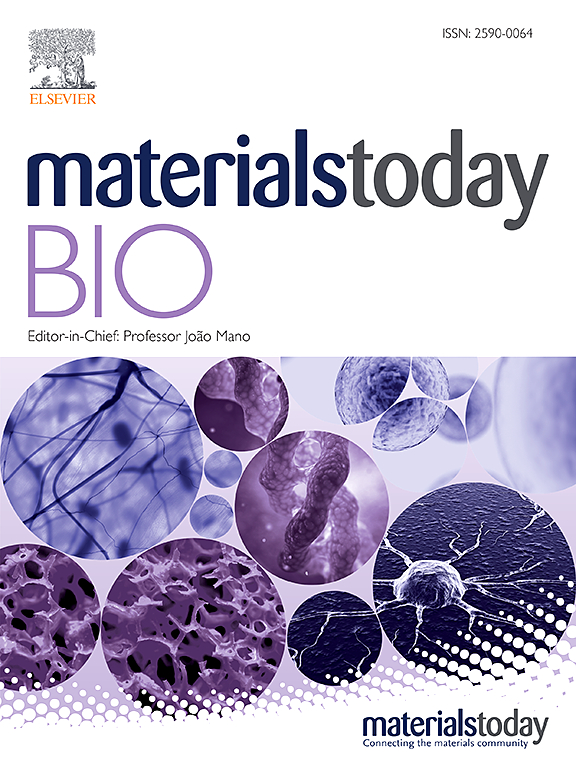Fabrication of GDNF-Gel/HA-Mg nerve conduit and its role in repairing peripheral nerve defects
IF 8.7
1区 医学
Q1 ENGINEERING, BIOMEDICAL
引用次数: 0
Abstract
Background
Magnesium (Mg) and its alloys are receiving increasing attention in peripheral nerve regeneration, but they were limited due to the low corrosion resistance and rapid degradation. In this study, GDNF-Gel/HA-Mg was prepared and its value in peripheral nerve defects repairment was explored both in vitro and in vivo.
Methods
A hydroxyapatite (HA) coating was first applied to the pure Mg surface, followed by the formation of gelatin methacrylate (GelMA) loaded with glial cell-derived neurotrophic factor (GDNF) on the HA-coated Mg surface. GDNF-Gel/HA-Mg corrosion resistance was explored. The effect of GDNF-Gel/HA-Mg conduit on Schwann cell proliferation and migration abilities were investigated. And sciatic nerve defects models were established to explored the role of GDNF-Gel/HA-Mg conduit in peripheral nerve defects repairment.
Findings
The electrochemical, immersion, and hydrogen evolution experiments indicated that the corrosion resistance in phosphate buffer saline (PBS) of pure Mg was significantly improved by the GDNF-Gel/HA coating. Cell cycle, Cell Count Kit-8 (CCK-8), and clone formation assays indicated that GDNF-Gel/HA-Mg promoted the proliferation of Schwann cells. Scratch and Transwell assay results demonstrated that GDNF-Gel/HA-Mg promoted Schwann cell migration ability dose-dependently. GDNF-Gel/HA-Mg was found to enhance the secretion of nerve growth factor (NGF) and the expression of p75NTR. Flow cytometry results showed that GDNF-Gel/HA-Mg could reduce H2O2-induced oxidative stress and Schwann cell apoptosis. GDNF-Gel/HA-Mg inhibited M1 macrophage polarization while facilitated M2 macrophage polarization in a concentration-dependent manner. The in vivo studies demonstrated that GDNF-Gel/HA-Mg conduit could significantly promote the regeneration and myelination of sciatic nerve, as well as the recovery of denervated gastrocnemius atrophy.
Interpretation
The GDNF-Gel/HA-Mg conduit prepared in this study exhibited good hydrophilicity and corrosion resistance and greatly enhanced the proliferation, migration, and invasion abilities of Schwann cells, as well as peripheral nerve regeneration.

GDNF-Gel/HA-Mg神经导管的制备及其在周围神经缺损修复中的作用
背景镁(Mg)及其合金在外周神经再生方面正受到越来越多的关注,但由于其耐腐蚀性低、降解快而受到限制。本研究制备了 GDNF-凝胶/HA-镁,并在体外和体内探讨了其在周围神经缺损修复中的价值。方法首先在纯镁表面涂上羟基磷灰石(HA)涂层,然后在 HA 涂层镁表面形成负载胶质细胞源性神经营养因子(GDNF)的甲基丙烯酸明胶(GelMA)。研究人员探讨了 GDNF-Gel/HA-Mg 的耐腐蚀性。研究了 GDNF-Gel/HA-Mg 导管对许旺细胞增殖和迁移能力的影响。研究结果电化学、浸泡和氢进化实验表明,GDNF-Gel/HA 涂层显著提高了纯镁在磷酸盐缓冲盐水(PBS)中的耐腐蚀性。细胞周期、细胞计数试剂盒-8(CCK-8)和克隆形成试验表明,GDNF-凝胶/HA-镁能促进许旺细胞的增殖。划痕和 Transwell 试验结果表明,GDNF-凝胶/HA-镁促进许旺细胞迁移的能力与剂量有关。GDNF-Gel/HA-Mg 还能促进神经生长因子(NGF)的分泌和 p75NTR 的表达。流式细胞术结果表明,GDNF-凝胶/HA-Mg 能降低 H2O2 诱导的氧化应激和许旺细胞凋亡。GDNF-Gel/HA-Mg 可抑制 M1 巨噬细胞的极化,同时促进 M2 巨噬细胞的极化,其作用呈浓度依赖性。体内研究表明,GDNF-凝胶/HA-镁导管可显著促进坐骨神经的再生和髓鞘化,以及去神经支配的腓肠肌萎缩的恢复。
本文章由计算机程序翻译,如有差异,请以英文原文为准。
求助全文
约1分钟内获得全文
求助全文
来源期刊

Materials Today Bio
Multiple-
CiteScore
8.30
自引率
4.90%
发文量
303
审稿时长
30 days
期刊介绍:
Materials Today Bio is a multidisciplinary journal that specializes in the intersection between biology and materials science, chemistry, physics, engineering, and medicine. It covers various aspects such as the design and assembly of new structures, their interaction with biological systems, functionalization, bioimaging, therapies, and diagnostics in healthcare. The journal aims to showcase the most significant advancements and discoveries in this field. As part of the Materials Today family, Materials Today Bio provides rigorous peer review, quick decision-making, and high visibility for authors. It is indexed in Scopus, PubMed Central, Emerging Sources, Citation Index (ESCI), and Directory of Open Access Journals (DOAJ).
 求助内容:
求助内容: 应助结果提醒方式:
应助结果提醒方式:


